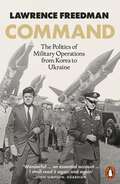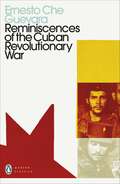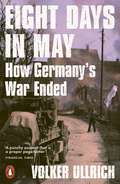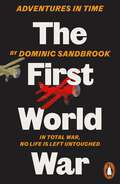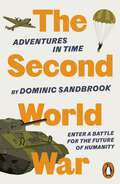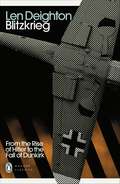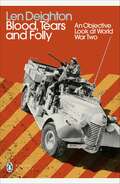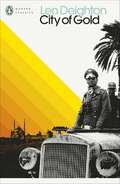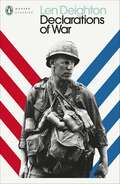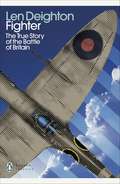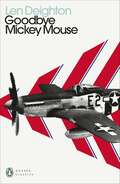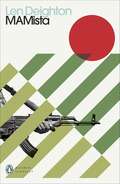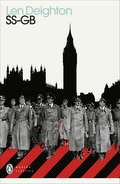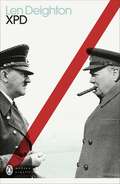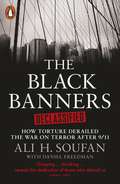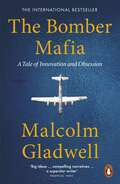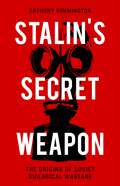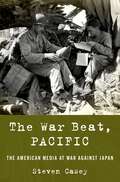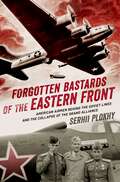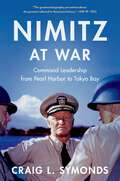- Table View
- List View
Command: The Politics of Military Operations from Korea to Ukraine
by Sir Lawrence FreedmanThroughout history, the concept of command -- as both a way to achieve objectives and as an assertion of authority -- has been essential to military action and leadership. But, as Sir Lawrence Freedman shows, it is also deeply political.Military command has been reconstructed and revolutionized since the Second World War by nuclear warfare, small-scale guerrilla land operations and cyber interference. Freedman takes a global perspective, systematically investigating its practice and politics since 1945 through a wide range of conflicts from the French Colonial Wars, the Cuban Missile Crisis and the Bangladesh Liberation War to North Vietnam's Easter Offensive of 1972, the Falklands War, the Iraq War and Russia's wars in Chechnya and Ukraine. By highlighting the political nature of strategy, Freedman shows that military decision-making cannot be separated from civilian priorities and that commanders must now have the sensibility to navigate politics as well as warfare.
Guerrilla Warfare (Penguin Modern Classics)
by Ernesto Che Guevara'Guerrilla warfare is a war of the masses, a war of the people'First published in 1961, following the successful Cuban Revolution, this is Che Guevara's handbook for guerrilla war.It covers strategy, tactics, terrain, organization of an army, logistics, field medical treatment, intelligence, propaganda and training, and focuses on seven 'golden rules' of guerrilla warfare. Widely studied both by insurrectionist movements and those who have tried to suppress them, this is the key text to understand how revolutions can be fought and won by ordinary people.
Reminiscences of the Cuban Revolutionary War (Penguin Modern Classics)
by Ernesto Che Guevara'Powerful and poetic ... For anyone interested in the myth of Che Guevara ... this book is essential reading' Colm Tóibín, Observer'We were an army of shadows, of ghosts, walking as if to the beat of some dark psychic mechanism...'The Cuban Revolution changed the course of the twentieth century. Following years of brutal tyranny and poverty, a band of idealistic young people fought against immense odds to overthrow a dictator and emerged victorious. This is the story of how they did it. Che Guevara's classic eyewitness account chronicles the transformation of a country, and of Che himself, from troop doctor to revolutionary icon.'Che's life is an inspiration for every human being who loves freedom' Nelson Mandela
Eight Days in May: How Germany's War Ended
by Volker Ullrich'The last days of the Third Reich have often been told, but seldom with the verve, perception and elegance of Volker Ulrich's rich narrative ... an instructive lesson in how societies cope with the devastating reality of a surrender that they grimly await' Richard Overy, author of The Bombing War'A fast-paced, brilliant recounting of the turbulent last days of the Third Reich, with all the energy and chaos of a Jackson Pollock canvas' Helmut Walser Smith, author of Germany: A Nation in its Time1 May 1945. The world did not know it yet, but the final week of the Third Reich's existence had begun. Hitler was dead, but the war had still not ended. Everything had both ground to a halt and yet remained agonizingly uncertain.Volker Ullrich's remarkable book takes the reader into a world torn between hope and terror, violence and peace. Ullrich describes how each day unfolds, with Germany now under a new Führer, Admiral Dönitz, based improbably in the small Baltic town of Flensburg. With Hitler dead, Berlin in ruins and the war undoubtedly lost, the process by which the fighting would end remained horrifyingly unclear. Many major Nazis were still on the loose, wild rumours continued to circulate about a last stand in the Alps and the Western allies falling out with the Soviet Union.All over Europe, millions of soldiers, prisoners, slave labourers and countless exhausted, grief-stricken and often homeless families watched and waited for the war's end. Eight Days in May is the story of people, in Erich Kästner's striking phrase, stuck in 'the gap between no longer and not yet'.
Adventures in Time: The First World War (Adventures in Time)
by Dominic SandbrookTake a journey to a vanished world with the ADVENTURES IN TIME series - stories so exciting you won't believe they're all true'The whistles blew, the cheers went up, and thousands of men were scrambling up into the rolling fields of No Man's Land . . .'Travel back in time to The First World War, as historian Dominic Sandbrook takes us from the soaring heights of an aeroplane cockpit to the desperate depths of the enemy trenches. We are plunged first hand into a conflict like no other as, amid the greatest clash of empires ever known, the future of the world hangs in the balance... The Adventures in Time series brings the past alive for twenty-first century children. These stories are every bit as exciting as those of Harry Potter or Matilda Wormwood. The only difference is they actually happened...
Adventures in Time: The Second World War (Adventures in Time)
by Dominic SandbrookTake a journey to a vanished world with the ADVENTURES IN TIME* series - stories so exciting you won't believe they're all true'Everything was ready. The air was thick with excitement. This was D-Day...' Prepare to enter the most dramatic conflict the world has ever seen, as historian Dominic Sandbrook takes us on a spine-tingling, heart-stopping adventure. We witness the Second World War first-hand through the eyes of ordinary people living in extraordinary times, from the women who worked all night in factories to the chess players who cracked unbreakable codes. Because in total war, no life is left untouched... The Adventures in Time series brings the past alive for twenty-first century children. These stories are every bit as exciting as those of Harry Potter or Matilda Wormwood. The only difference is they actually happened...*(Perfect for all readers who enjoy tales of heroes, villains, battles, escapes, codebreakers and a secret agent known as the Hedgehog)
Blitzkrieg: From the Rise of Hitler to the Fall of Dunkirk (Penguin Modern Classics)
by Len Deighton'Deighton has a desire, unobtrusive but inflexible, to see the truth ... Blitzkrieg is full of insights' Financial TimesThis is the story of the Nazi conquest of western Europe, from Hitler's rise to power and 'lightning-fast war', to his fatal mistake in halting the German advance on Dunkirk in 1940. Drawing on technical mastery and interviews with both Allied and German participants, Blitzkrieg sets out the technical thinking behind the attack and the weapons that made it possible. It is a compelling, detailed account of Europe's darkest hour. 'What Deighton did for the Battle of Britain in Fighter he has done for the land-war here ... A rattlingly good yarn' Guardian
Blood, Tears and Folly: An Objective Look at World War Two (Penguin Modern Classics)
by Len Deighton'Every page of Deighton's work glows with the excitement of discovery ... wonderful' Geoff Dyer, GuardianThis unflinching history of the darkest days of the Second World War covers the entire world stage, from the Battle of the Atlantic to Pearl Harbor. Rooted in the personal accounts of the soldiers themselves, Blood, Tears and Folly is a sweeping, moving account of the political machinations, the strategy and tactics, the weapons and the men on both sides who created a world of devastation.'If he had never written a word of fiction Deighton would still be remembered for his scholarly and merciless history of the Second World War, Blood, Tears and Folly' Peter Millar, The Times
City of Gold (Penguin Modern Classics)
by Len Deighton'A superb example of Deighton's craft' Robert HarrisJanuary 1942. Rommel's troops are at the gates of Egypt, soon to threaten Cairo itself. A spy has been leaking British secrets to the German commander, and Captain Albert Cutler has been sent to find them amongst the city's teeming streets and bazaars, before it is too late. But Cutler is not quite what he seems, and Cairo is a city of fool's gold, where nothing can be taken at face value.'The pace of the story is compulsive ... it is a real pleasure to be swallowed up in Deighton's descriptions of wartime Cairo' Daily Telegraph'A novel reminiscent in spirit to Casablanca. Play it again, Len' Kirkus Reviews
Declarations of War (Penguin Modern Classics)
by Len Deighton'Deighton really is something special' Sunday TimesLen Deighton's only collection of short stories explores the devastating experiences of ordinary soldiers across over two thousand years of war. From Hannibal's march on Rome to the American Civil War, and from a British Hurricane pilot in the Second World War to a modern conflict played out in the Mexican borderlands, each of these stories shows the effects of war on the human character, and how it can lead to extraordinary deeds, both great and terrible. 'Len Deighton is a fearless observer of the deceptive human world' John Gray
Fighter: The True Story of the Battle of Britain (Penguin Modern Classics)
by Len Deighton'The most honest attempt yet to tell how the Battle of Britain really was' Andrew Wilson, ObserverHistory is swamped by patriotic myths about the aerial combat fought between the RAF and the Luftwaffe over the summer of 1940. In his gripping history of the Battle of Britain, Len Deighton drew on a decade of research and his own wartime experiences to puncture these myths and point towards a more objective, and even more inspiring, truth.'Revolutionised thinking about the Battle of Britain in a way that has not been seriously challenged since' The Times
Goodbye Mickey Mouse (Penguin Modern Classics)
by Len Deighton'The sheer charge of the writing swept me into another world' The TimesDecember 1943. A group of US fighter pilots is camped at a windswept air base in Norfolk. Their job is to escort bombers over Germany, and each mission could be their last. Among them are cocky Lieutenant Mickey Morse (nicknamed 'Mickey Mouse'), who is almost on his way to becoming a Flying Ace, and reserved Captain Jamie Farebrother, who is starting to fall in love with an English woman. All they have in common is their courage - until the day their lives converge in ways they could never have imagined.'Truly astonishing in its recreation of a time and place ... it is a novel of memory, satisfying on every imaginable level' Washington Post
MAMista (Penguin Modern Classics)
by Len Deighton'A superb novel ... you will be hooked from the first chapter and enjoy every line' Sunday ExpressDeep in the South American jungle the MAMista Marxist revolutionaries are fighting a hopeless, protracted war against a dictator - while the CIA see an opportunity. Amid the turmoil, three very different people - a doctor, a young firebrand and an educated revolutionary - find themselves thrown together and trapped at the heart of a battle where the enemy is uncertain, and there can be no winners. Len Deighton's first post-Cold War novel is a chilling and compelling story of revolution and betrayal.'Moral ambiguity used to be called Greeneland. Since Graham Greene's death, at least part of it ought to be renamed Deightonsville' Time Magazine
SS-GB (Penguin Modern Classics)
by Len Deighton'Deighton's best book ... an absorbingly exciting spy story that is also a fascinating exercise in might-have-been speculation' The New York Times Book ReviewIt is 1941 and Germany has won the war. Britain is occupied, Churchill executed and the King imprisoned in the Tower of London. At Scotland Yard, Detective Inspector Archer tries to do his job and keep his head down. But when a body is found in a Mayfair flat, what at first appears to be a routine murder investigation sends him into a world of espionage, deceit and betrayal.'Len Deighton is the Flaubert of contemporary thriller writers ... this is much the way things would have turned out if the Germans had won' The Times Literary Supplement
XPD (Penguin Modern Classics)
by Len Deighton'A stunning spy story ... incomparable' GuardianIt is the most dangerous secret of the Second World War, one that could destroy Britain's reputation forever. In 1940, a clandestine meeting took place between Churchill and Adolf Hitler. All records of it have been hidden, and anyone who discovers the truth dies - their file stamped XPD; Expedient Demise. But now what was buried is threatening to come to light, and SIS agent Boyd Stuart must stop it falling into the wrong hands, no matter how high the price.'Deliciously sharp and flawlessly accurate dialogue, breathtakingly clever plotting ... a splendidly strongly told story' The Times
The Black Banners Declassified: How Torture Derailed The War On Terror After 9/11
by Ali SoufanA new, fully uncensored edition of the definitive insider's account of the War on Terror'A former FBI agent's memoir on the War on Terror is declassified after 9 years' Time'One of the most valuable and detailed accounts of its subject to appear in the past decade' EconomistThe ultimate insider's account of the battle against terrorism, Ali Soufan's revelatory account of his history-making decade as the FBI's lead investigator into al-Qaeda shaped our understanding of counter-terror operations - and led to hard questions being asked of American and British leaders. When The Black Banners was first published in 2011, significant portions of the text were redacted. After a CIA review those restrictions have been lifted, and the result is this explosive new edition, The Black Banners (Declassified). Alongside a new foreword by Soufan, the declassified documents uncover shocking details on the use of torture on terror suspects, how these 'enhanced interrogation techniques' failed to secure reliable intelligence, and in fact actively derailed the fight against al-Qaeda. By contrast we see Soufan at work using empathy and intelligent questioning - not force or violence - to extract some of the most important confessions in the war.Taking us from the interrogation rooms where Soufan would share food and films with the suspects so he could bond with them, to the hideouts of bin Laden, Ali Soufan reveals with intimate, first-hand knowledge the unbelievable truth about America's security agencies, 9/11, and the global 'War on Terror'.
The Bomber Mafia: A Story Set in War
by Malcolm Gladwell'A parable written for the age of technological disruption . . . brilliantly told' Sunday TimesThe international bestselling author returns with an exploration of one of the grandest obsessions of the twentieth century'The Bomber Mafia is a case study in how dreams go awry. When some shiny new idea drops from the heavens, it does not land softly in our laps. It lands hard, on the ground, and shatters.'In the years before the Second World War, in a sleepy air force base in central Alabama, a small group of renegade pilots put forth a radical idea. What if we made bombing so accurate that wars could be fought entirely from the air? What if we could make the brutal clashes between armies on the ground a thing of the past?This book tells the story of what happened when that dream was put to the test. The Bomber Mafia follows the stories of a reclusive Dutch genius and his homemade computer, Winston Churchill's forbidding best friend, a team of pyromaniacal chemists at Harvard, a brilliant pilot who sang vaudeville tunes to his crew, and the bomber commander, Curtis Emerson LeMay, who would order the bloodiest attack of the Second World War.In this tale of innovation and obsession, Gladwell asks: what happens when technology and best intentions collide in the heat of war? And what is the price of progress?
Stalin's Secret Weapon: The Origins of Soviet Biological Warfare
by Anthony RimmingtonStalin's Secret Weapon is a gripping account of the early history of the globally significant Soviet biological weapons program, including its key scientists, its secret experimental bases and the role of intelligence specialists, establishing beyond doubt that the infrastructure created by Stalin continues to form the core of Russia's current biological defense network. Anthony Rimmington has enjoyed privileged access to an array of newly available sources and materials, including declassified British Secret Intelligence Service reports. The evidence contained therein has led him to conclude that the program, with its network of dedicated facilities and proving grounds, was far more extensive than previously considered, easily outstripping those of the major Western powers. As Rimmington reveals, many of the USSR's leading infectious disease scientists, including those focused on pneumonic plague, were recruited by the Soviet military and intelligence services. At the dark heart of this bacteriological archipelago lay Stalin, and his involvement is everywhere to be seen, from the promotion of favored researchers to the political repression and execution of the lead biological warfare specialist, Ivan Mikhailovich Velikanov.
Stalin's Secret Weapon: The Origins of Soviet Biological Warfare
by Anthony RimmingtonStalin's Secret Weapon is a gripping account of the early history of the globally significant Soviet biological weapons program, including its key scientists, its secret experimental bases and the role of intelligence specialists, establishing beyond doubt that the infrastructure created by Stalin continues to form the core of Russia's current biological defense network. Anthony Rimmington has enjoyed privileged access to an array of newly available sources and materials, including declassified British Secret Intelligence Service reports. The evidence contained therein has led him to conclude that the program, with its network of dedicated facilities and proving grounds, was far more extensive than previously considered, easily outstripping those of the major Western powers. As Rimmington reveals, many of the USSR's leading infectious disease scientists, including those focused on pneumonic plague, were recruited by the Soviet military and intelligence services. At the dark heart of this bacteriological archipelago lay Stalin, and his involvement is everywhere to be seen, from the promotion of favored researchers to the political repression and execution of the lead biological warfare specialist, Ivan Mikhailovich Velikanov.
The War Beat, Pacific: The American Media at War Against Japan
by Steven CaseyThe definitive history of American war reporting in the Pacific theater of World War II, from the attack on Pearl Harbor to the atomic bombings of Hiroshima and Nagasaki. After almost two years slogging with infantrymen through North Africa, Italy, and France, Ernie Pyle immediately realized he was ill-prepared for covering the Pacific War. As Pyle and other war correspondents discovered, the climate, the logistics, and the sheer scope of the Pacific theater had no parallel in the war America was fighting in Europe. From Pearl Harbor to Hiroshima and Nagasaki, The War Beat, Pacific provides the first comprehensive account of how a group of highly courageous correspondents covered America's war against Japan, what they witnessed, what they were allowed to publish, and how their reports shaped the home front's perception of some of the most pivotal battles in American military history. In a dramatic and fast-paced narrative based on a wealth of previously untapped primary sources, Casey takes us from MacArthur's doomed defense on the Philippines and the navy's overly strict censorship policy at the time of Midway, through the bloody battles on Guadalcanal, New Guinea, Tarawa, Saipan, Leyte and Luzon, Iwo Jima and Okinawa, detailing the cooperation, as well as conflict, between the media and the military, as they grappled with the enduring problem of limiting a free press during a period of extreme crisis. The War Beat, Pacific shows how foreign correspondents ran up against practical challenges and risked their lives to get stories in a theater that was far more challenging than the war against Nazi Germany, while the US government blocked news of the war against Japan and tried to focus the home front on Hitler and his atrocities.
The War Beat, Pacific: The American Media at War Against Japan
by Steven CaseyThe definitive history of American war reporting in the Pacific theater of World War II, from the attack on Pearl Harbor to the atomic bombings of Hiroshima and Nagasaki. After almost two years slogging with infantrymen through North Africa, Italy, and France, Ernie Pyle immediately realized he was ill-prepared for covering the Pacific War. As Pyle and other war correspondents discovered, the climate, the logistics, and the sheer scope of the Pacific theater had no parallel in the war America was fighting in Europe. From Pearl Harbor to Hiroshima and Nagasaki, The War Beat, Pacific provides the first comprehensive account of how a group of highly courageous correspondents covered America's war against Japan, what they witnessed, what they were allowed to publish, and how their reports shaped the home front's perception of some of the most pivotal battles in American military history. In a dramatic and fast-paced narrative based on a wealth of previously untapped primary sources, Casey takes us from MacArthur's doomed defense on the Philippines and the navy's overly strict censorship policy at the time of Midway, through the bloody battles on Guadalcanal, New Guinea, Tarawa, Saipan, Leyte and Luzon, Iwo Jima and Okinawa, detailing the cooperation, as well as conflict, between the media and the military, as they grappled with the enduring problem of limiting a free press during a period of extreme crisis. The War Beat, Pacific shows how foreign correspondents ran up against practical challenges and risked their lives to get stories in a theater that was far more challenging than the war against Nazi Germany, while the US government blocked news of the war against Japan and tried to focus the home front on Hitler and his atrocities.
Forgotten Bastards of the Eastern Front: American Airmen behind the Soviet Lines and the Collapse of the Grand Alliance
by Serhii PlokhyThe full story of the first and only time American and Soviets fought side-by-side in World War II At the conference held in in Moscow in October 1943, American officials proposed to their Soviet allies a new operation in the effort to defeat Nazi Germany. The Normandy Invasion was already in the works; what American officials were suggesting until then was a second air front: the US Air Force would establish bases in Soviet-controlled territory, in order to "shuttle-bomb" the Germans from the Eastern front. For all that he had been pushing for the United States and Great Britain to do more to help the war effort--the Soviets were bearing by far the heaviest burden in terms of casualties--Stalin, recalling the presence of foreign troops during the Russian Revolution, balked at the suggestion of foreign soldiers on Soviet soil. His concern was that they would spy on his regime, and it would be difficult to get rid of them afterword. Eventually in early 1944, Stalin was persuaded to give in, and Operation Baseball and then Frantic were initiated. B-17 Flying Fortresses were flown from bases in Italy to the Poltava region in Ukraine. As Plokhy's book shows, what happened on these airbases mirrors the nature of the Grand Alliance itself. While both sides were fighting for the same goal, Germany's unconditional surrender, differences arose that no common purpose could overcome. Soviet secret policeman watched over the operations, shadowing every move, and eventually trying to prevent fraternization between American servicemen and local women. A catastrophic air raid by the Germans revealed the limitations of Soviet air defenses. Relations soured and the operations went south. Indeed, the story of the American bases foreshadowed the eventual collapse of the Grand Alliance and the start of the Cold War. Using previously inaccessible archives, Forgotten Bastards offers a bottom-up history of the Grand Alliance, showing how it first began to fray on the airfields of World War II.
Forgotten Bastards of the Eastern Front: American Airmen behind the Soviet Lines and the Collapse of the Grand Alliance
by Serhii PlokhyThe full story of the first and only time American and Soviets fought side-by-side in World War II At the conference held in in Moscow in October 1943, American officials proposed to their Soviet allies a new operation in the effort to defeat Nazi Germany. The Normandy Invasion was already in the works; what American officials were suggesting until then was a second air front: the US Air Force would establish bases in Soviet-controlled territory, in order to "shuttle-bomb" the Germans from the Eastern front. For all that he had been pushing for the United States and Great Britain to do more to help the war effort--the Soviets were bearing by far the heaviest burden in terms of casualties--Stalin, recalling the presence of foreign troops during the Russian Revolution, balked at the suggestion of foreign soldiers on Soviet soil. His concern was that they would spy on his regime, and it would be difficult to get rid of them afterword. Eventually in early 1944, Stalin was persuaded to give in, and Operation Baseball and then Frantic were initiated. B-17 Flying Fortresses were flown from bases in Italy to the Poltava region in Ukraine. As Plokhy's book shows, what happened on these airbases mirrors the nature of the Grand Alliance itself. While both sides were fighting for the same goal, Germany's unconditional surrender, differences arose that no common purpose could overcome. Soviet secret policeman watched over the operations, shadowing every move, and eventually trying to prevent fraternization between American servicemen and local women. A catastrophic air raid by the Germans revealed the limitations of Soviet air defenses. Relations soured and the operations went south. Indeed, the story of the American bases foreshadowed the eventual collapse of the Grand Alliance and the start of the Cold War. Using previously inaccessible archives, Forgotten Bastards offers a bottom-up history of the Grand Alliance, showing how it first began to fray on the airfields of World War II.
Nimitz at War: Command Leadership from Pearl Harbor to Tokyo Bay
by Craig L. SymondsFrom America's preeminent naval historian, the first full-length portrait in over fifty years of the man who won the war in the Pacific in World War Two"destined," says Andrew Roberts, "to be the defining life of Chester Nimitz for a long time to come." Only days after the Japanese attacked Pearl Harbor, President Franklin D. Roosevelt tapped Chester W. Nimitz to assume command of the Pacific Fleet. Nimitz was not the most senior candidate available, and some, including his new boss, U.S. Navy Admiral Ernest J. King, considered him a "desk admiral," more suited to running a bureaucracy than a theater of war. Yet FDR's selection proved nothing less than inspired. From the precarious early months of the war after December 7th 1941 to the surrender ceremony in Tokyo Bay nearly four years later, Nimitz transformed the devastated and dispirited Pacific fleet into the most powerful and commanding naval force in history. From the start, the pressures on Nimitz were crushing. Facing demands from Washington to mount an early offensive, he had first to revive the depressed morale of the thousands of sailors, soldiers, and Marines who served under him. He had to corral independent-minded subordinatesincluding Admiral Bill "Bull" Halsey and General Holland "Howlin' Mad" Smithand keep them focused on shared objectives. He had to maintain a sometimes-fraught relationship with his Army counterpart Douglas MacArthur, and cope with his superiors, including the formidably prickly King and the inscrutable FDR. He had to navigate the expectations of a nation impatient for revenge and eventual victory. And of course, he also confronted a formidable and implacable enemy in the Imperial Japanese Navy, which, until the Battle of Midway, had the run of the Pacific. Craig Symonds' Nimitz at War reveals how the quiet man from the Hill Country of Texas eventually surmounted all of these challenges. Using Nimitz's headquartersthe eye of the hurricaneas his vantage point, Symonds covers all the major campaigns in the Pacific from Guadalcanal to Okinawa. He captures Nimitz's composure, discipline, homespun wisdom, and most of all his uncanny sense of when to assert authority and when to pull back. In retrospect it is difficult to imagine anyone else accomplishing what Nimitz did. As Symonds' absorbing, dynamic, and authoritative portrait reveals, it required qualities of leadership exhibited by few other commanders in history, qualities that are enduringly and even poignantly relevant to our own moment.Â
Nimitz at War: Command Leadership from Pearl Harbor to Tokyo Bay
by Craig L. SymondsFrom America's preeminent naval historian, the first full-length portrait in over fifty years of the man who won the war in the Pacific in World War Two"destined," says Andrew Roberts, "to be the defining life of Chester Nimitz for a long time to come." Only days after the Japanese attacked Pearl Harbor, President Franklin D. Roosevelt tapped Chester W. Nimitz to assume command of the Pacific Fleet. Nimitz was not the most senior candidate available, and some, including his new boss, U.S. Navy Admiral Ernest J. King, considered him a "desk admiral," more suited to running a bureaucracy than a theater of war. Yet FDR's selection proved nothing less than inspired. From the precarious early months of the war after December 7th 1941 to the surrender ceremony in Tokyo Bay nearly four years later, Nimitz transformed the devastated and dispirited Pacific fleet into the most powerful and commanding naval force in history. From the start, the pressures on Nimitz were crushing. Facing demands from Washington to mount an early offensive, he had first to revive the depressed morale of the thousands of sailors, soldiers, and Marines who served under him. He had to corral independent-minded subordinatesincluding Admiral Bill "Bull" Halsey and General Holland "Howlin' Mad" Smithand keep them focused on shared objectives. He had to maintain a sometimes-fraught relationship with his Army counterpart Douglas MacArthur, and cope with his superiors, including the formidably prickly King and the inscrutable FDR. He had to navigate the expectations of a nation impatient for revenge and eventual victory. And of course, he also confronted a formidable and implacable enemy in the Imperial Japanese Navy, which, until the Battle of Midway, had the run of the Pacific. Craig Symonds' Nimitz at War reveals how the quiet man from the Hill Country of Texas eventually surmounted all of these challenges. Using Nimitz's headquartersthe eye of the hurricaneas his vantage point, Symonds covers all the major campaigns in the Pacific from Guadalcanal to Okinawa. He captures Nimitz's composure, discipline, homespun wisdom, and most of all his uncanny sense of when to assert authority and when to pull back. In retrospect it is difficult to imagine anyone else accomplishing what Nimitz did. As Symonds' absorbing, dynamic, and authoritative portrait reveals, it required qualities of leadership exhibited by few other commanders in history, qualities that are enduringly and even poignantly relevant to our own moment.Â
